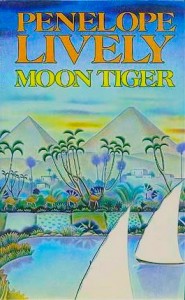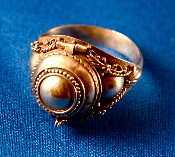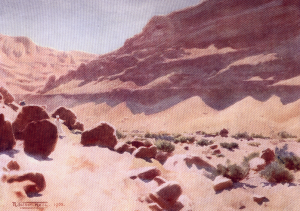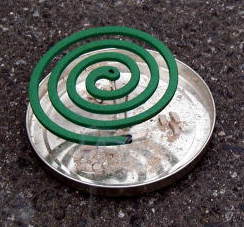Note: This novel was WINNER of the Booker Prize in 1987.
“I’m writing a history of the world…To round things off. I may as well—no more nit-picking stuff about Napoleon, Tito, the Battle of Edgehill, Hernando Cortez…The works this time. The whole triumphant murderous unstoppable chute – from the mud to the stars, universal and particular, your story and mine.”
 Claudia Hampton, an iconoclastic, sometimes imperious, often maddening, and completely liberated seventy-six-year-old woman, lies in a nursing home awaiting death—very reluctantly. Having worked as a reporter during the Cairo campaign in World War II, and later as a popular historian, she sees no reason why she should not continue her work as she awaits death. ‘Let me contemplate myself within my [own] context,” she says, “everything and nothing. The history of the world as selected by Claudia: fact and fiction, myth and evidence, images and documents.”
Claudia Hampton, an iconoclastic, sometimes imperious, often maddening, and completely liberated seventy-six-year-old woman, lies in a nursing home awaiting death—very reluctantly. Having worked as a reporter during the Cairo campaign in World War II, and later as a popular historian, she sees no reason why she should not continue her work as she awaits death. ‘Let me contemplate myself within my [own] context,” she says, “everything and nothing. The history of the world as selected by Claudia: fact and fiction, myth and evidence, images and documents.”
As she fades in and out of consciousness (her nurse wondering aloud to the doctor, “Was she someone?”), she plans her story for her usual readers, indicating that she will omit the narrative but “flesh it out; give it life and color, add the screams and the rhetoric…The question is, shall it or shall it not be linear history? I’ve always thought a kaleidoscopic view might be an interesting heresy. Shake the tube and see what comes out…There is no chronology inside my head. I am composed of a myriad Claudias who spin and mix and part like sparks of sunlight on water..there is no sequence, everything happens at once.”

Staying true to Claudia Hampton’s character, author Penelope Lively creates the kaleidoscopic narrative which Claudia is living inside her head, filling it with all the “screams and the rhetoric” Claudia has promised, examining the collective past which is also her own deeply private past, recreating her personal relationships with every member of her family and with every lover, even as she is trying to see how she is connected more broadly to her family history, and, indeed, the history of the world. Claudia also looks at her life microscopically, since she, like everyone else, creates a personal history which is unique–no two people see the same events the same way. Ultimately, she approaches the universal questions of “Do we matter?” and “Do our lives have meaning?” As the kaleidoscope turns, it reveals the “life and color” of Claudia’s different points of view at various times in her life, and even, occasionally, the points of view of others as they contemplate Claudia—her daughter Lisa, her brother Gordon, and Tom Southern, a soldier she met in Egypt.
 “In life as in history, the unexpected [always] lies waiting, grinning from around the corners,” and as Claudia remembers and dreams, she continually calls a spade a spade, recognizing the absurdities in her life at the same time that she sees the genuine joys and sadnesses. She gives remarkably insightful (though not necessarily polite) commentary on the people around her (at one point farting loudly when her meek sister-in-law comes to visit her in hospital), always trying to see how people became who they are and how they fit into the grand scheme of things. “Time and the universe lie around in our minds. We are sleeping histories of the world,” she asserts. And God has had little or no positive impact on it, she believes.
“In life as in history, the unexpected [always] lies waiting, grinning from around the corners,” and as Claudia remembers and dreams, she continually calls a spade a spade, recognizing the absurdities in her life at the same time that she sees the genuine joys and sadnesses. She gives remarkably insightful (though not necessarily polite) commentary on the people around her (at one point farting loudly when her meek sister-in-law comes to visit her in hospital), always trying to see how people became who they are and how they fit into the grand scheme of things. “Time and the universe lie around in our minds. We are sleeping histories of the world,” she asserts. And God has had little or no positive impact on it, she believes.
Gradually, Claudia’s life story emerges, stopping and starting, sometimes repeating almost word for word a brief event from the past, as if she cannot remember what she has already told us, flashing backward and forward, and finally bringing us back to the nursing home where she is living out her last days. From the beginning, we know that she has never married, that she has a daughter named Lisa whose father is Jasper, that she has been close to her brother but does not have anything in common with his wife Sylvia. We learn that, as a child, she was a problem to her teachers who believed that “Claudia’s intelligence may well prove a stumbling block unless she learns how to control her enthusiasms,” yet she goes on to Oxford to study history. She writes popular history books, and then, from 1940 – 1944, when she is nearly thirty, she is in Egypt, at one point cadging a ride to the desert front so she can report on the war and write feature stories, and where she meets an attractive soldier. The plot itself is obviously not the main focus.
know that she has never married, that she has a daughter named Lisa whose father is Jasper, that she has been close to her brother but does not have anything in common with his wife Sylvia. We learn that, as a child, she was a problem to her teachers who believed that “Claudia’s intelligence may well prove a stumbling block unless she learns how to control her enthusiasms,” yet she goes on to Oxford to study history. She writes popular history books, and then, from 1940 – 1944, when she is nearly thirty, she is in Egypt, at one point cadging a ride to the desert front so she can report on the war and write feature stories, and where she meets an attractive soldier. The plot itself is obviously not the main focus.
 Author Penelope Lively makes every sentence a cause for celebration here. By turns humorous, thoughtful, satiric, wonderfully philosophical, and consummately literary in its observations and allusions, this novel is an absolute treasure, one that will appeal to every lover of serious themes presented in new ways. Claudia, at seventy-six, will strike a chord with many readers, and as she contemplates the meaning of her own life and the connections she may have with the historical past, she comes alive and becomes deeply human. Brilliant in its analysis of end-of-life issues, it is also remarkably personal in its examination of love and what it means.
Author Penelope Lively makes every sentence a cause for celebration here. By turns humorous, thoughtful, satiric, wonderfully philosophical, and consummately literary in its observations and allusions, this novel is an absolute treasure, one that will appeal to every lover of serious themes presented in new ways. Claudia, at seventy-six, will strike a chord with many readers, and as she contemplates the meaning of her own life and the connections she may have with the historical past, she comes alive and becomes deeply human. Brilliant in its analysis of end-of-life issues, it is also remarkably personal in its examination of love and what it means.
ALSO by Penelope Lively: SPIDERWEB, HOW IT ALL BEGAN, THE PURPLE SWAMP HEN
Photos, in order: The author’s photo is from http://www.telegraph.co.uk.
The Winter Palace Hotel in Luxor is a place treasured by Claudia and Tom as they begin their love affair. http://www.hotelchatter.com
The one memento Claudia wants from Egypt is a ring, like the gold ring shown in the review, a poison ring, with a hidden compartment: http://shop.venturesterling.com/

Claudia then fills the ring’s hidden compartment with sand from the Mokattam Hills, which she visits. http://my.opera.com This painting of the hills is by R. Talbot Kelly (1861 – 1935).
Very ironically (and unromantically), “Moon Tiger” refers to a green coil of mosquito repellent which residents of Egypt used to combat mosquitos (and prevent malaria) during the summer.
